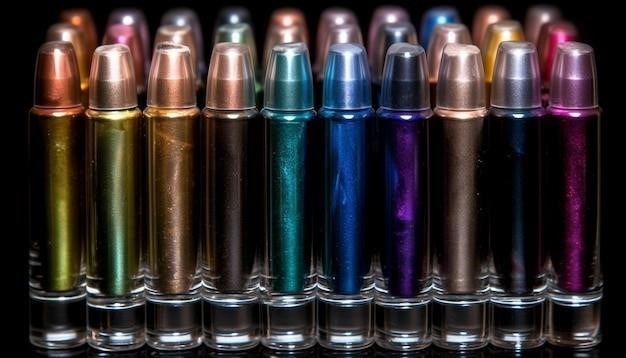Understanding the Color Wheel
The color wheel is a visual tool organizing colors to show their relationships. It structures discussions about color, allowing analysis of how colors interact. Understanding the wheel is key to effective color mixing and achieving desired hues.
Primary Colors
Primary colors are the foundational hues from which all other colors are derived. In the traditional RYB (Red, Yellow, Blue) color model, these three colors cannot be created by mixing other colors together. Red, a warm and vibrant hue, provides intensity and energy. Yellow, another warm color, offers brightness and optimism. Blue, a cool color, brings calmness and serenity. These primaries form the base of the color wheel, acting as building blocks for the secondary and tertiary colors. Understanding their unique characteristics and how they interact is crucial for successful color mixing. The intensity of a primary color can affect the final mixed color; a deep red will yield different results than a pale pink when mixed with another color. Mixing different shades and tints of primaries offers a vast range of color possibilities. Mastering the use of primary colors is essential for any artist or designer.
Secondary Colors
Secondary colors are created by mixing two primary colors in equal proportions. These vibrant hues sit midway between their parent primaries on the color wheel, inheriting qualities from both. Orange, a warm and energetic color, results from mixing red and yellow. Its cheerful nature makes it a popular choice in design and art. Green, a cool and refreshing color, is born from the union of blue and yellow. It represents nature and tranquility. Violet, a cool and sophisticated color, emerges from blending red and blue. Its regal air is often associated with luxury and mystery. The ratios of primary colors used can subtly alter the resulting secondary color. For example, a greater proportion of red in an orange mix will create a red-orange, while more yellow will yield a yellow-orange. Understanding these nuances is crucial for precise color mixing and achieving desired shades. The secondary colors provide a wider palette for creative expression, expanding possibilities beyond the limitations of the primary triad;
Tertiary Colors
Tertiary colors, also known as intermediate colors, are produced by mixing a primary color with an adjacent secondary color. These colors possess a unique blend of characteristics from both parent hues, resulting in a wide spectrum of nuanced shades. For instance, red-orange, a warm and energetic color, combines the boldness of red with the cheerfulness of orange. Yellow-orange, another warm hue, blends the vibrancy of yellow with the warmth of orange, creating a sunny and uplifting tone. Yellow-green, a cool and refreshing color, balances the brightness of yellow with the coolness of green, evoking images of fresh spring foliage. Blue-green, a cool and calming color, combines the serenity of blue with the tranquility of green, often associated with water and nature. Blue-violet, a cool and sophisticated color, marries the calmness of blue with the richness of violet, creating a regal and mysterious atmosphere. Red-violet, a warm and intense color, blends the energy of red with the depth of violet, resulting in a striking and dramatic hue. Tertiary colors offer a vast palette for artistic expression, adding complexity and depth to color schemes. Their subtle variations allow for a wide range of creative possibilities, expanding the capabilities of color mixing beyond primary and secondary hues.
Mixing Color Techniques
Mastering color mixing involves understanding color relationships on the wheel. Mixing warm and cool colors, creating tints and shades, and achieving specific hues are crucial skills for any artist. Experimentation is key to developing your own techniques.
Mixing Warm and Cool Colors
The color wheel is divided into warm and cool colors. Warm colors, such as reds, oranges, and yellows, evoke feelings of warmth and energy. They tend to advance visually, appearing closer to the viewer. Cool colors, including blues, greens, and purples, create a sense of calmness and serenity; they recede visually. Mixing warm and cool colors can produce a wide range of effects, from muted earth tones to vibrant contrasts.
A crucial aspect of mixing warm and cool colors is understanding how they interact. Mixing warm colors with other warm colors generally intensifies their warmth, resulting in richer, more saturated hues. Similarly, combining cool colors enhances their coolness, creating deeper, more tranquil shades. However, mixing warm and cool colors can lead to muddy or dull results if not done carefully. To avoid this, consider the proportions of each color. A small amount of a cool color added to a warm color might subtly shift the hue, while a larger amount can create a completely different color altogether.
Experimentation is key to mastering this technique. Observe how different ratios affect the final color, and note how subtle changes in proportion can dramatically alter the overall impression.
Creating Tints and Shades
Tints and shades are variations of a color achieved by adding white or black, respectively. Creating tints involves lightening a color by mixing it with white. The result is a pastel or lighter version of the original hue. The amount of white added determines the lightness of the tint; a small addition creates a subtle change, while a larger amount produces a significantly lighter shade. Tints are often used to create delicate and airy effects, particularly in painting and design.
Shades, conversely, are created by adding black to a color; This darkens the hue, creating a deeper, more intense version. Similar to tints, the amount of black influences the darkness of the shade. A small amount produces a subtle darkening, while a large quantity results in a much darker, almost muted tone. Shades are frequently employed to add depth and contrast to artwork, creating shadows and highlighting textures.
Understanding how to create tints and shades is crucial for controlling the value and overall mood of a color scheme. This technique allows for a wide range of subtle variations within a single color family, adding richness and sophistication to any artistic or design project.
Achieving Specific Hues
The color wheel serves as an invaluable guide for achieving precise hues. By understanding the relationships between primary, secondary, and tertiary colors, artists and designers can systematically mix colors to obtain almost any desired shade. For instance, to achieve a vibrant orange, one would start with a base of red and gradually add yellow, adjusting the ratio until the desired intensity and saturation are reached. The process is iterative, requiring careful observation and adjustments to achieve the perfect hue.
Creating more complex hues often involves manipulating the color’s value and saturation. Adding white creates tints, lightening the hue, while adding black produces shades, darkening it. These adjustments help to fine-tune the color to fit specific needs within a broader color scheme. For example, a muted orange might be created by adding a small amount of black to a vibrant orange, or a pastel orange could be created by mixing it with white. The key is experimentation and a thorough grasp of the color wheel’s structure.
Digital tools can aid in the process, providing precise color mixing and allowing for easy adjustments. However, a foundational understanding of color theory, as illustrated by the color wheel, remains essential for achieving the desired hues consistently and accurately, regardless of the medium used.
Practical Applications
The color wheel’s principles extend across various creative fields. From painting and digital art to design, understanding color mixing enhances artistic expression and achieves specific aesthetic goals.
Color Mixing for Painting
Understanding the color wheel is paramount for painters. Whether working with oils, acrylics, or watercolors, the wheel guides the mixing process. For instance, knowing that red and yellow create orange allows for precise hue control. Mixing warm colors with warm and cool colors with cool prevents muddy results, a common issue for beginners. The wheel also aids in creating tints (adding white) and shades (adding black), offering vast tonal variations. A painter can use the color wheel to achieve specific hues by carefully selecting and blending primary, secondary, and tertiary colors. Experimentation is crucial; the wheel provides a framework, but individual pigments behave differently. This hands-on approach refines color mixing skills, enabling painters to achieve their artistic vision with greater precision and control. The color wheel is not just a guide; it is a tool for exploration and mastery of color in painting.
Color Mixing for Digital Art
Digital art utilizes the color wheel in a unique way, leveraging its principles within digital painting software and design programs. Unlike physical paint mixing, digital color mixing is non-destructive; adjustments are easily made. The RGB (red, green, blue) color model, fundamental to digital displays, directly relates to the color wheel’s primary colors. Understanding color harmonies, such as complementary or analogous colors, becomes crucial for creating visually appealing digital art. Digital artists can use the color wheel to achieve specific hues by adjusting RGB sliders or using color pickers that reference the wheel’s structure. The ability to easily shift between color spaces (RGB, CMYK) also offers flexibility. Moreover, many digital art programs feature interactive color wheels, providing real-time feedback during the mixing process. This allows for rapid experimentation and precise color selection, enhancing the artist’s control and efficiency in creating vibrant and harmonious digital artworks.
Color Mixing in Design
Graphic design leverages the color wheel extensively for creating visually appealing and effective designs. Understanding color relationships is crucial for branding, website design, and print materials. Designers utilize the color wheel to select harmonious color palettes that evoke specific moods or communicate brand messaging effectively. For instance, complementary colors can create high contrast and visual excitement, while analogous colors provide a sense of harmony and coherence. The principles of tint, shade, and tone are vital for adjusting color saturation and brightness to achieve the desired level of visual impact. Design software often incorporates interactive color wheels, enabling designers to experiment with different color combinations and visualize their effects on the overall design. Moreover, the color wheel aids in ensuring color consistency across various design elements and media. Careful consideration of color psychology, guided by the color wheel, is essential for creating designs that resonate with the target audience and achieve the desired communication goals.
Advanced Color Theory
Exploring advanced color theory delves into color harmonies, including complementary, analogous, and triadic relationships, significantly impacting design and artistic expression. Mastering these principles elevates color choices.
Color Harmonies
Color harmony, a cornerstone of effective color mixing, refers to the pleasing arrangement of colors in a composition. Several key harmonies exist, each offering unique visual effects. Understanding these harmonies allows for intentional and aesthetically successful color palettes. Complementary harmonies, using colors opposite each other on the color wheel (like blue and orange), create vibrant contrast. Analogous harmonies, employing colors adjacent to each other (such as blue, blue-green, and green), provide a sense of calm and coherence. Triadic harmonies, utilizing three colors evenly spaced on the wheel (like red, yellow, and blue), offer a balanced and lively combination. Split-complementary harmonies, using a base color and the two colors adjacent to its complement, provide a more nuanced version of complementary harmony. Tetradic harmonies, using four colors forming a rectangle on the wheel, present a complex and potentially dynamic interplay. The choice of harmony depends on the desired mood and visual impact. Careful consideration of value and saturation further refines the harmony, ensuring a balanced and visually appealing result. Experimentation and observation are crucial in mastering the art of color harmony. The color wheel serves as a valuable guide, simplifying the exploration and application of various harmonious color schemes;
Complementary Colors
Complementary colors, a fundamental concept in color theory, are pairs of colors situated directly opposite each other on the color wheel. This strategic positioning creates a high degree of visual contrast, making them ideal for achieving vibrancy and visual interest. The most classic examples include blue and orange, red and green, and yellow and purple. When used together, complementary colors enhance each other, with each color appearing brighter and more saturated against its counterpart. However, a crucial aspect of using complementary colors lies in achieving balance. An equal balance of both colors can sometimes lead to a jarring effect; therefore, adjusting the values (lightness or darkness) and saturation (intensity) of each color is key to achieving a harmonious outcome. For instance, using a darker shade of one color and a lighter shade of its complement can soften the contrast and create a more subtle yet still striking effect. The skillful manipulation of value and saturation is what transforms potentially clashing colors into a visually appealing and harmonious palette. By understanding the nuances of these adjustments, artists and designers can harness the power of complementary colors to create dynamic and memorable works.
Analogous Colors
Analogous colors represent a harmonious and often serene color scheme. These colors are positioned adjacent to each other on the color wheel, sharing a common hue but varying in their lightness and saturation. For instance, a group of analogous colors might include blues ranging from a deep teal to a light sky blue, or greens spanning from a vibrant emerald to a muted sage. The inherent similarity in hue creates a visually cohesive and pleasing effect. This makes analogous color schemes particularly suitable for creating calming and balanced designs. The subtle gradations between the colors offer a sense of flow and visual continuity. They are frequently used in nature-inspired designs or where a soothing and peaceful atmosphere is desired. However, to prevent the scheme from becoming monotonous, designers often incorporate one color as a dominant hue, using the others as accents to add depth and visual interest. Careful consideration of value and saturation variations within the analogous range is key to avoid a flat or uninteresting composition. Mastering the use of analogous colors allows for the creation of sophisticated and aesthetically pleasing palettes.



